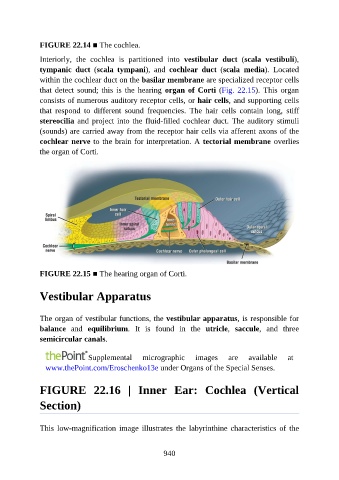Page 941 - Atlas of Histology with Functional Correlations
P. 941
FIGURE 22.14 ■ The cochlea.
Interiorly, the cochlea is partitioned into vestibular duct (scala vestibuli),
tympanic duct (scala tympani), and cochlear duct (scala media). Located
within the cochlear duct on the basilar membrane are specialized receptor cells
that detect sound; this is the hearing organ of Corti (Fig. 22.15). This organ
consists of numerous auditory receptor cells, or hair cells, and supporting cells
that respond to different sound frequencies. The hair cells contain long, stiff
stereocilia and project into the fluid-filled cochlear duct. The auditory stimuli
(sounds) are carried away from the receptor hair cells via afferent axons of the
cochlear nerve to the brain for interpretation. A tectorial membrane overlies
the organ of Corti.
FIGURE 22.15 ■ The hearing organ of Corti.
Vestibular Apparatus
The organ of vestibular functions, the vestibular apparatus, is responsible for
balance and equilibrium. It is found in the utricle, saccule, and three
semicircular canals.
Supplemental micrographic images are available at
www.thePoint.com/Eroschenko13e under Organs of the Special Senses.
FIGURE 22.16 | Inner Ear: Cochlea (Vertical
Section)
This low-magnification image illustrates the labyrinthine characteristics of the
940

